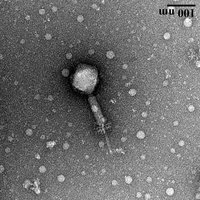Corynebacterium phage Ikaros
Know something about this phage that we don't? Modify its data.
| Detailed Information for Phage Ikaros | |
| Discovery Information | |
| Isolation Host | Corynebacterium glutamicum NRRL B-2784 |
| Found By | Lauren Alvaro |
| Year Found | 2016 |
| Location Found | Fort Myers, FL USA |
| Finding Institution | Florida Gulf Coast University |
| Program | Science Education Alliance-Phage Hunters Advancing Genomics and Evolutionary Science |
| From enriched soil sample? | Yes |
| Isolation Temperature | 30°C |
| GPS Coordinates | 26.46137 N, 81.781302 W Map |
| Discovery Notes | Sample was collected from the FGCU Food Forest. The sample was taken from a plotted plant. The soil was slightly moist. The sample was then enriched in Corynebacterium glutamicum and plated on both C. glutamicum and Gordonia terrae. Results at first indicated that the phage was able to grow on both hosts; however, further tests revealed that the phage could only grow on C. glutemicum. Calculations show that the concentration of the high titer lysate is greater than approximately 3.45 x 10^12. However, there may have been a technical issue with the serial dilution done to calculate this number, seeing as the number of plaques per plate did not decrease tenfold each plate, but stayed relatively the same. |
| Naming Notes | The name for this phage comes from Greek mythology. Icarus was the son of Daedalus, who created wings from wax and feathers so that they could escape their prison tower. Icarus ignored his father's instructions not to fly too close to the sun, and his wax melted, causing his wings to fall apart. This phage is named after Icarus, because it is one of my favorite Greek myths. (Íkaros is the Greek spelling.) |
| Sequencing Information | |
| Sequencing Complete? | No |
| Sequencing Facility | University of Pittsburgh Genomics and Proteomics Core Laboratories |
| Genome length (bp) | Unknown |
| Character of genome ends | Unknown |
| Fasta file available? | No |
| Characterization | |
| Cluster | Unclustered |
| Subcluster | -- |
| Annotating Institution | Unknown or unassigned |
| Annotation Status | Not sequenced |
| Plaque Notes | The plaques are clear and approximately 0.7mm in diameter. |
| Morphotype | Myoviridae |
| Has been Phamerated? | No |
| Publication Info | |
| Uploaded to GenBank? | No |
| GenBank Accession | None yet |
| Refseq Number | None yet |
| Archiving Info | |
| Archiving status | Archived |
| Pitt Freezer Box# | 44 |
| Pitt Freezer Box Grid# | H2 |
| Available Files | |
| Plaque Picture | Download |
| EM Picture | Download |

